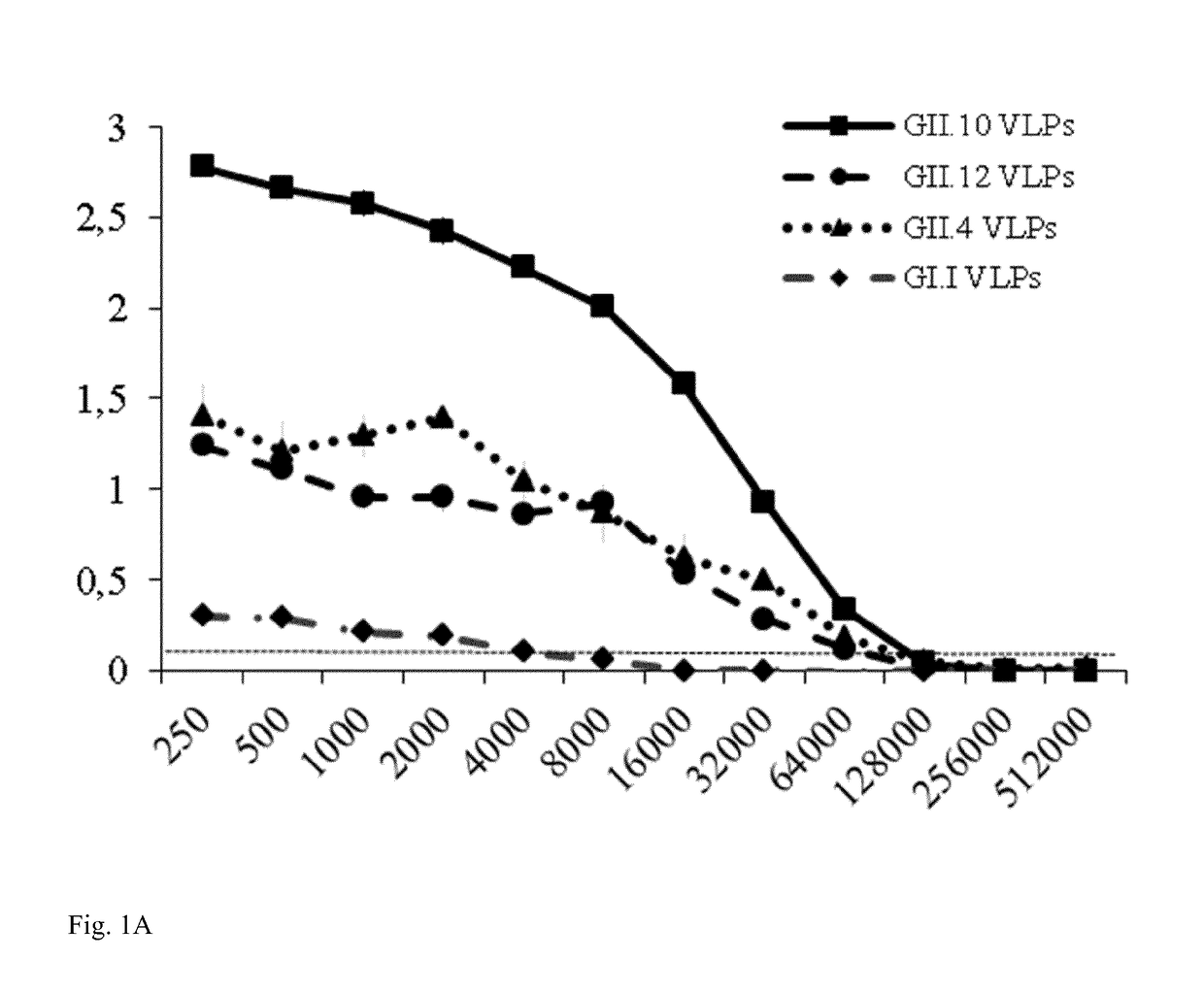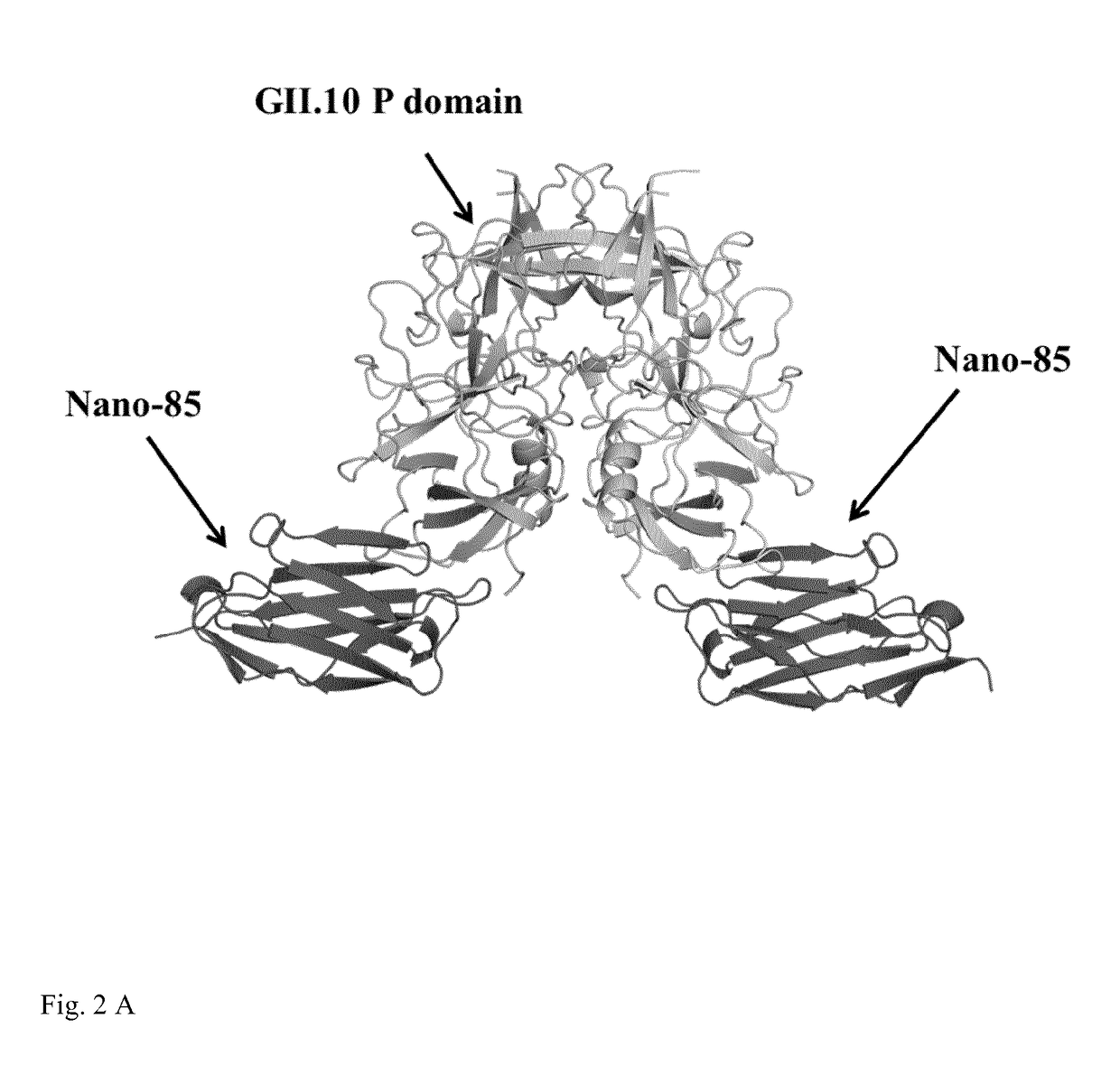Norovirus antibodies
a technology of norovirus and antibodies, applied in the field of binding polypepts, can solve the problems of hampered vaccine and antiviral development, cannot grow in cell culture, etc., and achieve the effect of destroying the structure of norovirus particles
- Summary
- Abstract
- Description
- Claims
- Application Information
AI Technical Summary
Benefits of technology
Problems solved by technology
Method used
Image
Examples
example 1
and Methods
VLP Production
[0108]The capsid gene of Norovirus GII.10 Vietnam026 (AF504671), GII.12 Hiro (AB044366), GI.1 Norwalk virus (AY502016), and GII.4 NSW-2012 (AFV08795) was cloned into a baculovirus expression system as previously described (Hansman, G. S., L. T. Doan, T. A. Kguyen, S. Okitsu, K. Katayama, S. Ogawa, K. Natori, N. Takeda, Y. Kato, O. Nishio, M. Noda, and H. Ushijima. 2004. Detection of norovirus and sapovirus infection among children with gastroenteritis in Ho Chi Minh City, Vietnam. Arch Virol 149:1673-1688; Lin, C. M., F. M. Wu, H. K. Kim, M. P. Doyle, B. S. Michael, and L. K. Williams. 2003. A comparison of hand washing techniques to remove Escherichia coli and caliciviruses under natural or artificial fingernails. J Food Prot 66:2296-2301). VLPs were harvested at five days post infection. The supernatant was pelletized and applied to a 15-45% sucrose ultracentrifugation gradient (Beckmann SW40-Ti rotor) for 2 h at 4° C. Fractions were confirmed using EM and...
example 2
Nanobody Binding Specificity
[0115]Nano-85 was analyzed in this study. Initially, the Nanobody binding characteristics were analyzed with GII.10 VLPs and the corresponding P domain (FIG. 1A). Nano-85 detected GII.10 VLPs at a dilution of 64,000 (˜170 pM). A similar binding pattern was also observed with GII.10 P domains, where Nano-85 detected the P domains at dilutions of 17,800. The cross-reactivities of the Nanobody were analyzed using VLPs from other genotypes (GI.1, GII.4 (NSW-2012), and GII.12). Nano-85 detected GII.4 and GII.12 VLPs at a dilution of 32,000 (˜340 pM) and GI.1 VLPs at a lower dilution of 4,000 (FIG. 1A).
[0116]A sandwich ELISA was performed to confirm the binding of Nano-85 to intact particles. Wells were first coated with GII genotype specific monoclonal antibodies and then GII.10, GII.12, and GII.4 (NSW-2012) VLPs were added. Nano-85 detected the captured GII.10, GII.12, and GII.4 VLPs at dilutions of 17,280, 8,640, and 2,160, respectively (FIG. 1B). Twelve GII...
example 3
ly of Norovirus VLPs by Nano-85
[0123]GII.10 VLPs (FIG. 4) were incubated with the following antibodies: control (no antibody) (FIG. 4A); monoclonal 5B18 IgG (as disclosed in EP 2 757 111 A1, FIG. 4 B), Nano-85 (FIG. 4 C), and Nano-25 (FIG. 4 D). Nano-25 is a nanobody binding to a similar site of the norovirus VLP, but contacting different amino acids of the viral capsid. As shown in FIG. 4, only Nano-85 causes disassembly of the VLPs. FIG. 5 shows results of the analogous experiment using GII.4 VLPs.
PUM
| Property | Measurement | Unit |
|---|---|---|
| Fraction | aaaaa | aaaaa |
Abstract
Description
Claims
Application Information
 Login to View More
Login to View More - R&D
- Intellectual Property
- Life Sciences
- Materials
- Tech Scout
- Unparalleled Data Quality
- Higher Quality Content
- 60% Fewer Hallucinations
Browse by: Latest US Patents, China's latest patents, Technical Efficacy Thesaurus, Application Domain, Technology Topic, Popular Technical Reports.
© 2025 PatSnap. All rights reserved.Legal|Privacy policy|Modern Slavery Act Transparency Statement|Sitemap|About US| Contact US: help@patsnap.com



